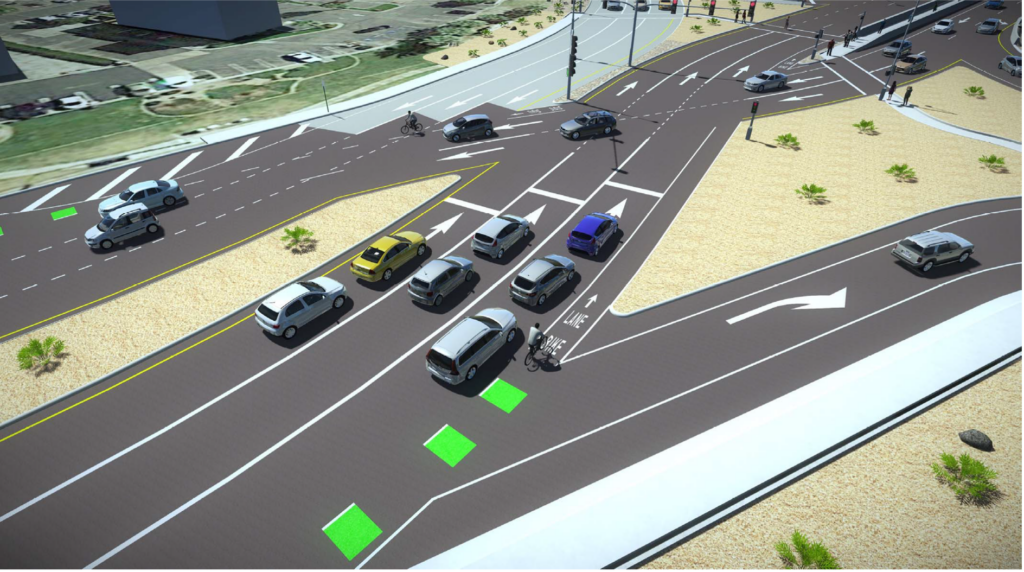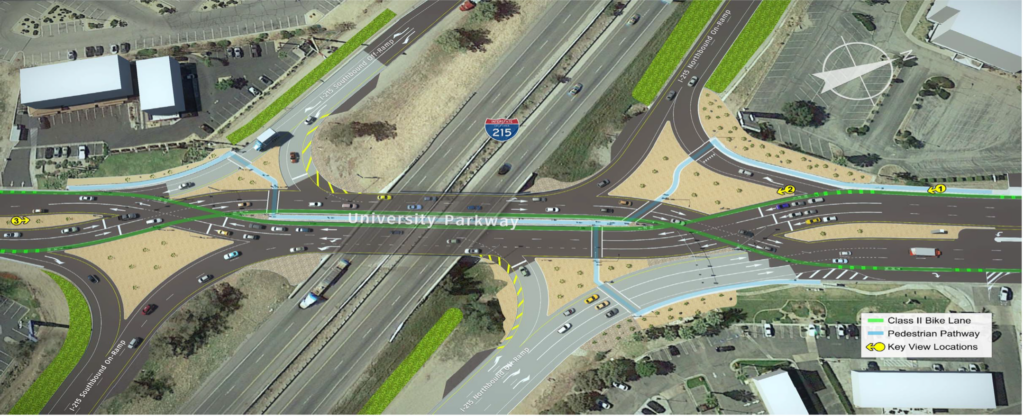Introducing the Diverging Diamond Interchange
November 4, 2024

As you travel along Interstate 215 (I-215) near University Parkway, keep an eye out for some exciting changes on the horizon. Construction is set to begin on a diverging diamond interchange (DDI), a modern traffic solution that intends to transform the way drivers navigate this busy intersection.
This innovative design is a first for our county and has been gaining popularity in the transportation world for its efficiency and effectiveness. By updating the traffic pattern and minimizing the number of conflicts with opposing traffic, the DDI enhances traffic flow and improves safety for commuters, pedestrians and cyclists passing through.
Let’s dive into why these improvements are needed, what this means for the surrounding community and how it could positively reshape the daily travel experience through this corridor.
Why a change is needed
University Parkway provides a direct connection from I-215 to the campus of California State University San Bernardino, and along the way there are grocery stores, restaurants and shopping centers that support the local community made up of single-family homes and apartments. To the east of I-215 you’ll find warehouses supporting the movement of goods through the region.
A majority of the student body and faculty drive to the campus daily when classes are in session, which brings added cars to the area. When combined with drivers going to or from work, appointments, deliveries, or running errands, traffic through the interchange causes delays. In many cases, drivers wait multiple green light cycles before getting through the interchange.
How will a DDI improve conditions?
A DDI will allow more cars to pass through the interchange during a green light cycle and create a safer center median sidewalk with concrete barriers between vehicles and pedestrians.
Driver safety is increased because the risk for severe traffic collisions is reduced. Vehicles turning or merging left onto I-215 no longer have to cross oncoming traffic, reducing the risk of collisions.
The DDI will accommodate future growth at the college campus and surrounding community, help reduce greenhouse gas emissions from cars idling at the interchange, and create a safer experience for everyone passing through.
How it works
To reduce the amount of cross-traffic left turns, the traffic pattern of a DDI is different than most traditional interchanges but is easy for drivers to navigate.
Using the below rendering for reference, as traffic on University Parkway approaches I-215, it switches to the left side of the road at a traffic signal. After traveling under the interstate, traffic switches back to the right side of the roadway.
As drivers approach the interchange, access onto I-215 is available by merging right onto the onramp prior to the interchange. If merging left onto I-215, drivers would pass under the interstate then merge left to the onramp without having to cross oncoming traffic.

Where are these being built?
DDIs are relatively new in California. The first one opened in the central valley city of Manteca in 2020 and more are planned in the region to support increases in population and commerce. The first DDI in southern California opened in 2022 at the Otay Mesa Port of Entry.
You can find DDIs in many other states across the country including Missouri, which opened the first one in the U.S. in 2009.
Will we see more in San Bernardino County?
While DDIs are a great solution to improving safety at highway interchanges, they are not always a perfect fit for every interchange. SBCTA and Caltrans will continue to explore them as options where they make sense.
The DDI at I-215 and University Parkway is scheduled to begin construction in November 2024. The interchange will remain open during construction and traffic signs will help drivers navigate changes in traffic patterns. Construction in the area is expected to be complete in late 2025.
Learn more about the DDI project at I-215 and University Parkway here.
